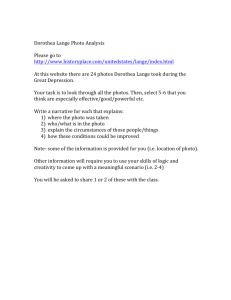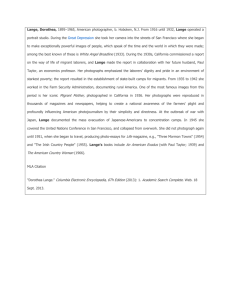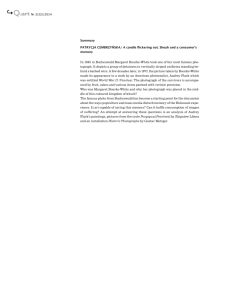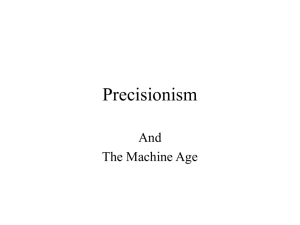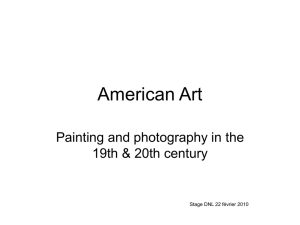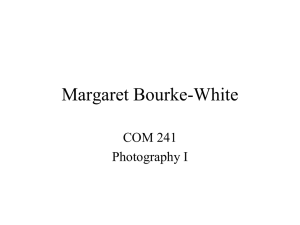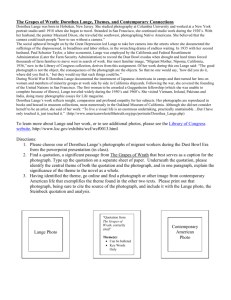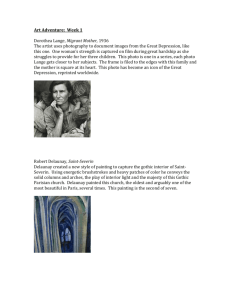Fighting for the Oppressed - part 2
advertisement
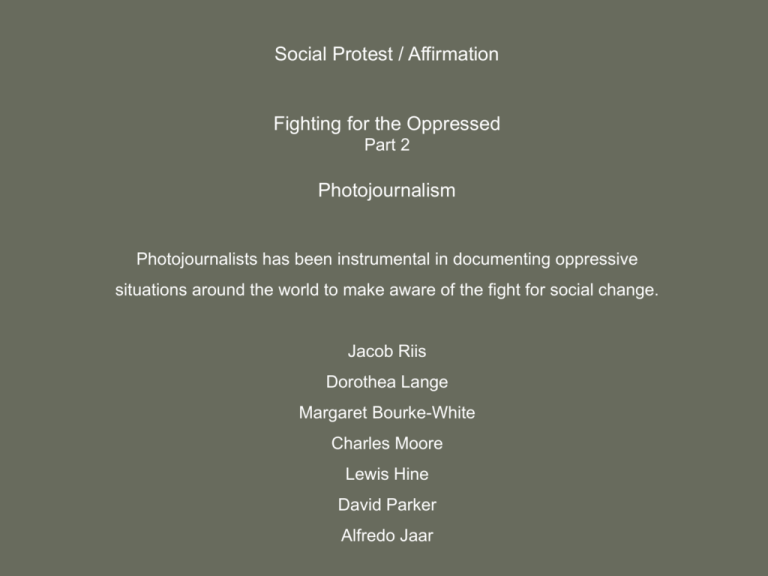
Social Protest / Affirmation Fighting for the Oppressed Part 2 Photojournalism Photojournalists has been instrumental in documenting oppressive situations around the world to make aware of the fight for social change. Jacob Riis Dorothea Lange Margaret Bourke-White Charles Moore Lewis Hine David Parker Alfredo Jaar Bandits Roost 59 ½ Mulberry Street New York City 1888 Jacob Riis photographed the living conditions of the low-class people in New York City in the 1880s and 1890s. He donated the photographs to the Museum of the City of New York. Five cents a Spot New York City 1890 Burying the Dead Hart’s Island, Bronx, New York 1890 Jacob Riis A class in condemned Essex School New York City 1902 Dorothea Lange was hired by the Farm Security Administration (FSA) to document the living conditions during the Depression-era of the 1930s. White Angel Breadline, San Francisco 1933 Living Conditions, Lindsey, California 1939 Heading West, Tulare Lake, California 1939 Dorothea Lange photojournalist Lettuce Cutters, Salinas, California 1935 Hoe Culture, Alabama 1937 Dorothea Lange was hired again in the early 1940s by the War Relocation Authority to record the forced evacuation of Japanese-American to internment camps. Executive Order 9066 San Francisco, California Few Weeks before Executive Order 9066, 1942 San Francisco, California 1942 Dorothea Lange Manzanar Relocation Center Manzanar, California 1942 Executive Order 9066, Centerville, California 1942 Wearing ID Tags, Hayward, California 1942 During the 1930s, Bourke-White photographed drought victims of the Dust Bowl. Margaret Bourke-White At the Time of the Louisville Flood 1937 Margaret Bourke-White was the first female war correspondent and the first woman allowed in combat zones during WWII. She traveled to the Soviet Union, North Africa, Italy and the concentration camp at Buchenwald. Margaret Bourke-White The Living Dead of Buchenwald, 1945 Henri Cartier-Bresson Shanghai 1948 Punjab, India 1947 Lynching of Thomas Shipp and Abram Smith Marion, Indiana 1930 Various photographers documented the gruesome and inhumane treatment of African-Americans by American whites. Lynching in Omaha, Nebraska 1919 Segregated Bus 1930 Joseph Postigilione The Aftermath of a Mob Attack on a Freedom Ride Bus, Anniston, AL 1960s Birmingham, Alabama Charles Moore documented the civil rights movement and the Vietnam War. His images helped to spur the passage of the Civil Rights Act of 1964. Water Cannon 1963 1963 Lewis Hine recorded children working in factories and in other types of laborious work. His images helped to pass the Child Labor Laws of the 1930s Boys working in a Milk Factory “Just Happened In” Newberry, SC. The overseer said apologetically, "She just happened in." She was working steadily. The mills seem full of youngsters who "just happened in" or "are helping sister." A group of newsies selling on the Capitol steps. Tony, age 8, Dan, 9, Joseph, 10, and John, age 11. Lewis Hine photojournalist Breaker boys. Smallest is Angelo Ross. Pittston, Pennsylvania. Children picking cotton Leather tannery worker Injured fireworks worker Guatemala Bangladesh 1993 1999 Sex workers in front of a brothel Thailand David Parker wrote Before Their Time: The World of Child Labor, which documented the exploitation of children in the late 20th Century, which still occurs. 1993 Forming bricks Peru 1998 David Parker Looking for conch shells in a mangrove swamp Nicaragua 2004 Hauling bricks for firing Nepal 1995 Each brick weighs 4-9 lbs Hauling 1000-2000 bricks per day Alfredo Jaar Gold in the Morning series 1985 Alfredo Jaar Gold in the Morning 1985 Alfredo Jaar The Rwanda Project 1994-2000 The Silence of Nduwayezu Alfredo Jaar The Geometry of Conscience Memorial 2010 Museum of Memory and Human Rights Lights dim every 90 seconds in memory of the victims of Pinochet’s 17 year dictatorship.
